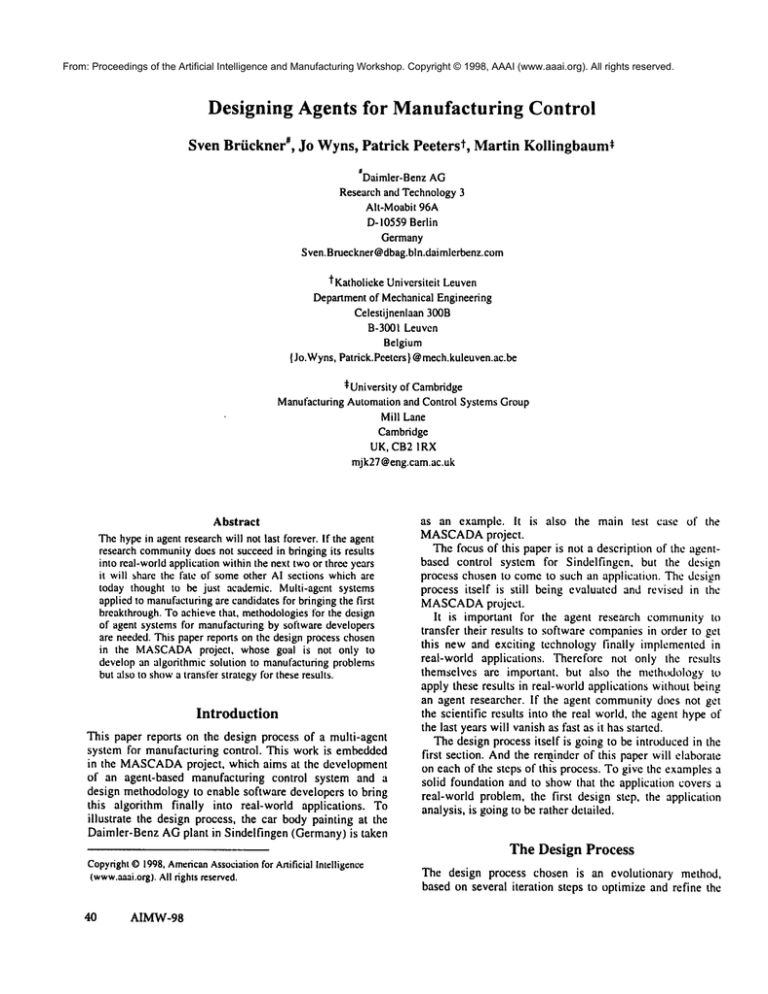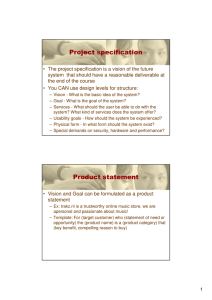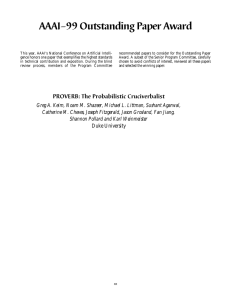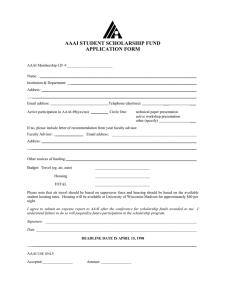
From: Proceedings of the Artificial Intelligence and Manufacturing Workshop. Copyright © 1998, AAAI (www.aaai.org). All rights reserved.
Designing Agents for Manufacturing Control
Sven Briickner#, Jo Wyns, Patrick Peeterst,
Martin Kollingbaum*
#
Daimler-Benz AG
Research and Technology3
AIt-Moabit 96A
D- 10559Berlin
Germany
Sven.Brueckner @dbag.bln.daimlerbenz.com
tKatholieke Universiteit Leuven
Department of Mechanical Engineering
Celestijnenlaan 300B
B-3001 Leuven
Belgium
{Jo.Wyns,Patrick.Peeters } @mech.kuleuven.ac.be
~University of Cambridge
Manufacturing Automation and Control Systems Group
Mill Lane
Cambridge
UK, CB2 IRX
mjk27@eng.cam.ac.uk
Abstract
Thehype in agent research will not last forever. If the agent
research communitydoes not succeed in bringing its results
into real-world application within the next two or three years
it will share the fate of someother AI sections whichare
today thought to be just academic. Multi-agent systems
applied to manufacturingare candidatesfor bringing the first
breakthrough. To achieve that, methodologiesl’or the design
of agent systems for manufacturing by software developers
are needed. This paper reports on the design process chosen
in the MASCADA
project, whose goal is not only to
develop an algorithmic solution to manufacturing problems
but also to showa transfer strategy for these results.
Introduction
This paper reports on the design process of a multi-agent
system for manufacturing control. This work is embedded
in the MASCADA
project, which aims at the development
of an agent-based manufacturing control system and a
design methodology to enable software developers to bring
this algorithm finally into real-world applications.
To
illustrate the design process, the car body painting at the
Daimler-Benz AGplant in Sindelfingen (Germany) is taken
as an example. It is also the main test case of the
MASCADAproject.
The focus of this paper is not a description of the agentbased control system for Sindelfingen,
but the design
process chosen to come to such an application. The design
process itself is still being evaluated and revised in the
MASCADA
project.
It is important for the agent research community to
transfer their results to software companies in order to get
this new and exciting technology finally implemented in
real-world applications.
Therefore not only the results
themselves are important, but also the metht,dology to
apply these results in real-world applications without being
an agent researcher. If the agent community does not get
the scientific results into the real world, the agent hype of
the last years will vanish as fast as it has started.
The design process itself is going to be introduced in the
first section. And the reminder of this paper will elaborate
on each of the steps of this process. To give the examples a
solid foundation and to show that the application covers a
real-world problem, the first design step, the application
analysis, is going to be rather detailed.
The Design Process
CopyrightO1998,American
Associationfor Artificial Intelligence
(www.aaai.org).
All rights reserved.
4O
AIMW-98
The design process chosen is an evolutionary
method,
based on several iteration steps to optimize and refine the
From: Proceedings of the Artificial Intelligence and Manufacturing Workshop. Copyright © 1998, AAAI (www.aaai.org). All rights reserved.
reached solution.
It starts with a very intensive analysis of the domain.
This is necessary to enable the agent designer to understand
the real-world processes and the optimization goals. It is
assumedthat there is already an existing production system
which has to be provided with a new control system. That
assumption reflects not only the situation in Sindelfingen
but it also applies to most of today’s agent projects. This
assumptionis offering a migration strategy.
The outcomeof this first step is a process modeland an
ontology. The process model will be used to identify the
single agents. The ontology helps to specify the distribution
of knowledgein the agent system and gets useful whena
larger or wider distributed group of project partners is
supposedto cooperate.
After the application domainanalysis, the design of the
multi-agent system begins. The design is an iteration
process where each loop results in a more and more refined
and optimal agent system. This process can be stopped after
any nl ,nber of loops dependingon the criteria the control
system has to fulfill. The single steps in this design loop
are;
1.
Domainanalysis / Determinationof the goals of that
iteration.
2. Specification of the agent types and their typical
interactions.
3. Specification of each agent type’s knowledge,
abilities and behavior.
4. Identification of the agents in the application.
5. Evaluation of the system.
This design process is a specialization
of design
methodologies
suggested in (Parunak 1997) and
(Burmeister 1996). These methodologies do not focus
the manufacturing domain and therefore they cannot
suggest, as this paper does, an abstract concept from where
to start the design. The Parunakpaper presents techniques
for an informal evaluation of the design which should be
applied here as well. The distinction in three models(agent
model, organizational model, cooperation model) as
Burmeister suggests is not that explicit
in the
manufacturingcontrol domain.But its aspects are still valid
issues to apply.
The examples in the following sections show, howthe
design process is applied to the Sindelfingen domain.
1The Application
Domain
The domainconsidered is the last section of the painting
cent~:r of the Daimler-Benz AGpassenger car plant in
Sindelfingen, Germany.This section covers two painting
steps and their correspondingrecovery procedures, all used
to producea perfectly painted car body.
I Different domainanalyses can be found in the deliverable
of work package one in the MASCADA
project. It will be
available on the MASCADA
WWW-site:
www.mech.kuleuven.ac.belproject/mascada/welcome.html
At first glance it seemsto be a simple, straight forward
task for a control systemto transport the car bodies to the
different processing stations and eventually out of the
building.
However, a deeper analysis reveals two problems:
feedbacks and buffering.
A feedback loop inserts car bodies after one or more
recovery steps back into the production system. Becauseit
is not possible to throttle back the input stream into the
system, this results in an increased and mixedinput stream
of car bodies, every time a car bodydoes not pass a quality
check. The increased input stream increases the load of the
processing units, which on their turn results in more
reparations and as a consequencein an even moreincreased
feedback.
The following picture shows an abstract model of the
production process. The nodes in the depicted graph are the
processing steps, while the arcs are virtual streams of car
bodies.
The picture showsthree main feedback loops. One into the
first mainprocessing step ,,Basic Layer Painting" via the
recovery processing ,,Basic Layer Grinding" and the other
two leading into the ,,Final LayerPainting" step via ,,Final
Layer Grinding"or ,,Repair Preparation" respectively.
IFinal LayerPainting(FLPI
I
"J Final Layer
Grinding(FLG)
I
~q
I
;
~ Repair Preparat,on(RPI
[Spot
Repair
(SR)
I
Picture 1 - FeedbackLoops in the Process Model
A quality check is performedafter each main processing
step determining if a car bodycan pass on to the next main
step (or to the exit) or if it has to comeback via one of the
recovery steps. Whichof the recovery actions is to be taken
is decidedthere as well.
Buffering betweenthe processing steps is another control
problem. Twotypes of buffering are possible in the system.
One is used to store car bodies during shift changes and
breaks or to buffer breakdownsand other delays in the
succeeding resources. The buffers of this kind are simple,
roughlyfirst-in-first-out storage buffers.
The other, more complicated buffer type is a sorting
Brtlckner
41
From:buffer.
Proceedings
ofbuffers
the Artificial
and Manufacturing
Workshop.
Copyright
1998,
AAAI (www.aaai.org).
All
reserved.
These
are Intelligence
able to access
virtually any
car
Take© an
efficiency
breakdown
inrights
FLPI
as an example.
bodywithin its storage for the next output. The function of
these sorting buffers is to rearrange car streams. Because
the performanceof the "Final Layer Painting"-yield mainly
dependson the hatch size of cars that have to be painted in
the same color, each "Final Layer Painting" unit has a
preceding sorting buffer to rearrange the input stream in a
stream of cars that have to be painted in the samecolor. As
a consequence, the performances of these buffers have a
great impact on the overall performance of the
manufacturing
In order to get a complete model of the manufacturing
process, it is necessary to specify the numberof processing
units of each type and the transport and buffering
conditions between them.
The amountof car bodies going through RPI is increasing
drastically while less car bodies can leave the system. But
all car bodies coming out of RPI are going into FLP3
without being sorted in SBI. That results in a higher load
for FLP3and an almost certain decrease in FLP3efficiency
(partially unsorted stream). A lower efficiency means
higher load for RPi and so on. A good control system
wouldhave to throttle back the input into FLPIbecause the
real source for the trouble in FLP3and RPIlies there. So it
is very complicatedto find the right balance and to keep it.
In a distributed control system this balance could be the
emergingfeature of the agents behavior.
First Iteration
I
.
f
r
RP: i
V
V
Picture 2 - CompleteProcess Model
The transport system imposes strong constraints on the
ability of the control system to shift the streams between
the processing units during an efficiency breakdownof the
processing units. An efficiency breakdownis a situation
where the overall number of cars going into a feedback
loop increases drastically and therefore the load of the
system reaches dangerouslevels.
Aslong as the load of the systemis lowor the efficiency
of the painting lines is high enoughto ensure that at least
the same number of car bodies leaves the system as new
car bodies are comingin, the control job is easy. But if the
inflow of cars increases drastically or the efficiency is
breaking downthe decisions to be taken are getting to
complexfor a centralized system to handle.
42
AIMW-98
In a first step of each iteration, the goals that have to be
reachedat the end of that iteration must be defined. In case
of the manufacturing control system of the Sindelfingen
plant the goalsof the first iteration are:
every car body must have been
1. Eventually,
processed.
2. The performance of the new control system should
be at least as goodas the performanceof the existing
one. The performance measures used are:
throughput, yield, idle resources, congestion levels
and operability.
3. The new control system must be able to cope with
drastic disturbances like complete breakdownsof
processingcapabilities.
4. The new control system must try to balance the
system even during quality breakdowns.
So the aim of the first iteration is the developmentof an
agent-based manufacturingcontrol system, that is able to
safely control the manufacturing process. Other
requirements such as reaching optimal results in terms of
the production output are maintained for future iterations.
This is sensible because the manufacturingprocess itself is
already complex enough. The control system should be
simple in the beginning and get more complex after the
basics have been understood.
Agent Types and Interactions
(First Level of Abstraction)
The PROSA
manufacturing control reference architecture
(VanBrussel et al. 1998, Bongaertset al. 1996) is used
the basis for the design of the agent-based manufacturing
control system. PROSA,standing for Product-ResourceOrder-Staff Architecture, originates from a research project
on Holonic Manufacturing Systems (Valckenaers et al.
1998). It defines the entities that makeup a manufacturing
control system, their responsibilities,
and their
relationships.
The PROSAconcept has been developed with a
background in Holonic Manufacturing Systems but for the
purpose of this paper the difference between holons and
From: Proceedings of the Artificial Intelligence and Manufacturing Workshop. Copyright © 1998, AAAI (www.aaai.org). All rights reserved.
agents is irrelevant as (Bussmann1998) suggests.
PROSA
defines three types of essential (basic) agents:
Product-Agents, Resource-Agents, and Order-Agents.
Product-Agents take care of product and process related
technological aspects such as which operations need to be
performed to achieve the product. Resource-Agents take
care of resource aspects such as driving a machine at
optimal speed and maximizingits capacity. Andfinally, the
Order-Agents take care of logistical concerns about
customer demandsand due dates. A fourth type of agent is
the Staff-Agent which is optional. The Staff-Agents may
assist the basic agents in performing their task more
optimally.
The following sections show. on the basis of the
Sindelfingen
example, how the agent types of a
manufacturing control system can be derived from the
PROSA
concept. Because the application design in the
Sindelfingendomainis still in the first iteration, the agents
are still very simple in terms of knowledge and
interactions. Further iterations will surely introduce some
Staff-Agents and makethe basic agents more complex.
The Order- and Product-Agents
Starting from the PROSA
concept, the agent types for the
Sindelfingen application are derived. The most obvious
agent is the Car-Agent.A Car-Agentis a specialization of
the Order-Agentconcept. This agent is responsible for an
order to be fulfilled. Anorder represents the task to process
a car body in a certain way with a set of parameters
specifying all necessaryprocessingsteps in full detail.
Onespecial feature is added to the Car-Agent:the CarAgentis not only responsible for an order, but also for the
car bodythat correspondsto that order. If this car bodygets
so badly damagedduring processing that the order cannot
be fulfilled the Car-Agentis responsible for extracting the
car body safely from the production system instead of
trying to find another car bodyto fulfill the order. After the
release of the car body, the Car-Agentcan be killed as well.
As a consequence, there will never be a Car-Agentwithout
a car bodyand vice versa.
The Sindelfingen application is rather static in terms of
product- and process changes. Therefore the functionality
of the Product-Agent to provide the Order-Agent with
processing information is integrated into the Car-Agent
itself. No non-abstract agent type was derived from the
Product-Agentduring the first design loop.
The Resource- and Product-Agents
For the Sindelfingen application, the abstract concept of
a Location-Agent is derived. The Location-Agent is a
specialization of the Resource-Agent.
It represents a clearly
defined area of sometransport units and possibly one or
more processing units. Hencea Location-Agent’s area has
someentries and someexits where car bodies can enter or
leave respectively. In this area, the agent has complete
control over the transport or processing of the car body. It
is able to change the direction of a car body based on
knowledge about possible transportation goals in the
overall layout and the (partial) mappingonto exits of its
ownarea. Therefore, the location of a car body is not a
mere parameter of the Car-Agentbut it represents the fact
that the car body is under the physical control of the
Location-Agent.
From the Location-Agent, three different agents are
derived: the Switch-, the Machine-and the Buffer-Agent.
Switch-Agents are Location-Agents with only transport
units in their area. Thereforethey represent a pure transport
resource taking car bodies in throughits entries and sending
themout throughtheir exits. Inside its area of influence the
Switch-Agent can direct the car bodies according to its
policy.
A Machine-Agenthas at least one processing unit within
its area and therefore it provides some (aggregated)
processing to the incomingcar bodies. It could also switch
car bodies along its processing units but its mainfocus is
the processing. The functionality of the Product-Agentto
provide the Machine-Agentwith data on howto process an
order correctly has been integrated into the Machine-Agent
itself. With its aggregated processing abilities, the
Machine-Agentalready knowsall the actions necessary to
fulfill a proposedprocessing step without asking any other
agent.
A Buffer-Agentis very similar to a Switch-Agent.It also
contains no processing units within its area. But because of
its internal layout and its special transport strategy a
Buffer-Agentis able to store car bodies within its area. The
Buffer-Agents area can be made up of simple transport
units used to store car bodies or it could contain a special
buffering device. In the second case the Buffer-Agentjust
wrapsit.
The following picture showsthe derivation of the used
agent types from the PROSA
concept.
[ PROSAconc,pt [
",
1
q
Location-Agent
Picture 3 - Agents Derived from PROSA
Types of Interaction
The abstract types of interaction can be derived from the
PROSA
concept as well. An Order-Agent interacts with a
Brfickner
43
From:
Proceedings ofabout
the Artificial
Intelligence
andresource
Manufacturing
Copyright
© 1998, AAAI
All rights
reserved.
Resource-Agent
the usage
of the
for Workshop.
the
first specification
of(www.aaai.org).
the implementation
of the
agent types.
order. And the Product-Agent is providing the other two
agent types with information on the further production
steps of the order. So there are interactions on resourceusage (Order-Machine), order-processing
(ProductMachine)and order-completion (Product-Order).
Applying these abstract classes of interaction to the
intended application and the derived agent types is the next
step in the design process. Starting with the responsibilities
of the non-abstract agent types, the types of interaction can
be specified in moredetail.
In the Sindelfingen case only one of the three abstract
interaction types are still visible in external agent behavior,
because there is no non-abstract agent type derived from
the Product-Agent. The order-processing interaction is
hidden in the internal knowledgeof the Machine-Agenton
howto actually fulfill a processing step. Andthe ordercompletioninteraction takes place internally whenthe CarAgentdetermines the next processing step based on the car
body’scurrent processingstate.
The resource-usageinteraction type is split up according
to the different resources the Resource-Agents are
responsible for. In general there are twodifferent resources
handled by agents. Transport resources are handled by all
Location-Agents and therefore each agent is able to
participate in interactions about transport. OnlyMachineAgents are responsible for processing resources. So the
interactions about processing only happen between the
Machine-Agentsand Car-Agents. The agent specification,
secondlevel or’ abstraction, will specify all the interactions
of these twotypes.
I Product ]
order- ,~
~order- ~pletion
proces~,~/J Resource [,,,
resource-usage
g/;
I
!
,
n
I
.,J OrderJ
I
about
/ ]
I Lo0tion
t .._transoo.;’/
I
II
II
- "aboutprocessing
Picture 4 - Interaction Types
(Second Level of Abstraction)
During this design step , the knowledge, abilities and
behavior specific to each agent type is going to be
specified. Furthermorethe interactions betweenthe agents
are fleshed out. The result of this step is going to be the
AIMW-98
Specification of a Multi-Agent System
In object-oriented design the Unified ModelingLanguage
(UML) has emerged as a quasi standard for the
specification. It does not only cover the structure or" the
object model,but it also contains constructs to describe the
use of the systemin typical situations (use-cases) and the
message passing process between objects (sequence
diagrams).
Agents derived from the PROSAconcept seem to be
quite simple compared to more complex agents used in
domains like information gathering or human-machine
interfacing. Theyare still close to the object-oriented world
and it seems worthwhileto look at object-oriented methods
like UML
for their specification.
Another reason makingthe UML
approach interesting as
a specification format is the interactivity of the agents.
Besides specifying what the single agent is responsible for
and what it knows, the interactions between the agents in
certain situations are very important. These interactions
provide triggers for manyactions of the agents and if they
are not specified correctly the implementationof the agent
system wouldnot be possible.
So, which UMLconstructs can be used for the agent
specification’? Use-casesfor the specification of important
situations and the global behavior of the agent system;
sequencediagrams for the concrete definition of the agents
interactions and an object modelto describe the knowledge
of an agent.
For the first version of the MASCADA
multi-agent
system for the painting center in Sindelfingen important
situations in the agent interactions were specified using a
use-cases-like format. These situations are (i) the
determination of the fulfillment of the next processing step
beginning with the completionof the previous one and (ii)
the routing of a car bodythrough the transport system.
As an example, the representation of the request of the
next processing step sent by a Buffer-Agentto a Car-Agent.
The representation of this situation looks as follows:
Car
I
Agent Specification
44
Questions arising about specific agents in the application
are tackled whenthe general agent type is in :in applicable
form. This specification is concernedwith the distributed
algorithmin general.
Request of next
/~
processingstep
~
Car-Agent
Buffer-Agent
Picture 5 - Use-Casesfor Situations
After the identification of the situations wherethe agents
have to interact, the interactions themselves have to be
defined. The appropriate tool for specifying the interactions
are sequence diagrams. In a sequence diagram the
exchanged messages, the internal actions and even the
usage of different threads for the processing of events can
be defined.
From: Proceedings of the Artificial Intelligence and Manufacturing Workshop. Copyright © 1998, AAAI (www.aaai.org). All rights reserved.
The simple interaction on the next processing step can be
represented in this short sequencediagram:
[ Car’Agent I
"question [ Buffer-Agent [
processing
step"
~ send question
~
instantiatedSend
next~_~ "answer ~
processingstep
processing
store information
alongwithcar
~ body registration
step"
Picture 6 - SequenceDiagramsfor Interactions
The names of the used messages are written above the
arrows depicting the exchangeof messagesbetweenagents.
Internal actions are namednext to the "lifeline" of each
agent and the threads are the boxeson top of the "lifelines".
The next step of the interaction specification is the
formal definition of each messagein the interaction. Each
message is defined by its message name (or ID), the
sending and receiving agent type and the data sent by the
messages parameters. A message specification could look
like this:
(<Buffer-Agent> <Car-Agent> <ProtocolNumber> question_processing_step)
Withthe specification of the sent messagesthe external
behavior of an agent is defined. To complete the
specification of the agents, the internal actions and the
knowledge of each agent has to be added. Both are
emergingfrom the previous steps. The internal actions have
already been named in the sequence diagrams and some
knowledgeof an agent has shownup in the declaration of
the messages. But the agent designer should always check
if there are someinternal interactions with the underlying
systems which could lead to more internal actions than the
interactions betweenthe agents suggest.
The specification of the internal actions will not use any
UMLderived features. The actions could be specified in
graphical form like a program graph. But a verbal
description should be sufficient. The structure of the agents
knowledgecould be represented in an object diagram. But
often it is not so structured and a listing if the data items is
moreappropriate.
Identifying Agents for the Application
However,the agent types have been completely specified,
the design process still hasn’t produceda workingcontrol
system for the manufacturing process yet. The specified
multi-agent system is still based on abstract agent types
without any application to the actual layout and special
features of the actual application. So the next step will
groundthe multi-agent systeminto reality.
Toreach that goal, the agent designer has to identify all
agents in the application. That meansthe identification of
all instantiations of each agent type. This is done by
looking at the domainanalysis. First of all Machine-Agents
and some Buffer-Agents can be found in the process model
of the painting center. Thenthe agent designer has to look
at the actual layout of the transport systemto find all the
Switch-Agents and probably somemore Buffer-Agents.
A rule of thumb during this design phase is that there
should be no areas in the production system without an
agent which include more than linear transport. Howfine
grained the multi-agent system will be in the end and in
whoseagent’s area the single transport units will end up is
a design decision whichcan be revised in later iterations of
the design process whenthe need arises.
Further Iterations
After having implemented and tested the agent-based
control system in a simulation system, the results have to
be analyzed. To measure the quality of the new control
system, a simulation of the current control systemusing the
same test scenarios has to be comparedwith the results
from the new control system. In the Sindelfingen
application it will be possible to emulatethe behaviorof the
current control system with the agent-based control system.
That decreases the resources needed for the implementation
of the simulation.
The evaluation of the agent-based control system is done
in simulation. To simulate the underlying processes
correctly, data from the in-depth analysis are needed. The
digital mock-upincludes the production equipment, the
actual layout of the resources and their correct behavior. It
is importantfor a correct evaluation to get the simulationas
close to reality as possible.
To create the right test scenarios for the simulation,
domainknowledgefrom the analysis of the application is
needed. The evaluation should take place in real-world
scenarios. This is importantfor the later acceptanceof the
new control system because it wouldbe muchto expensive
to set up real-world experimentsin the plant.
The analysis of the tests of the agent-based control
systemshould focus on the following issues:
¯ Is the implementation correct?
¯
Is the algorithm workingcorrectly?
¯ / no car body that has been processed wrongly
¯ / no car bodylost by its agent
¯
Howgood is the algorithm qualitatively?
¢" deadlocks, fairness, stability
¯ Howgood is the algorithm quantitatively?
¢’ numbers of processed car bodies
’/ load of the processing units
¯ Is the chosen algorithmic approach feasible?
In answeringall these questions the evaluation will lead
to a set of goals the next iterations of the design process
will have to reach. Eventually the evaluation of the reached
design will showthat all objectives of the project are
fulfilled and the design of the multi-agent system is
completed. The next step will then hopefully be an
implementationof the multi-agent control system in a real
Brtickner
45
From: Proceedings of the Artificial Intelligence and Manufacturing Workshop. Copyright © 1998, AAAI (www.aaai.org). All rights reserved.
product. This could uncover new problems with the realworld whichcould lead to further design loops.
For the Sindelfingen application the following iterations
in the design process will focus on more advanced issues
like optimal operational results, maintenance, human
control in assigning strategies, emerging strategies and
adaptation. Furthermore a feedback from the control
systemsdesign into the actual layout of the plant is goingto
be addressed. One outcome of the MASCADA
project
should be suggestions on howto change the layout to get
even better results with an agent-basedcontrol system.
In general this evaluation step bridges the gap between
the design of a multi-agent system for a certain global
behavior and the specification of the single agents. An
exampleis the agent-based control system for Sindelfingen.
The specification of the agents never mentions scheduling
explicitly but the multi-agent system shows an emergent
scheduling behavior during runtime. Therefore the design
problemis to reach a certain global behavior of a complex
systemonly through the specification of the single entities
it is madeof. Andthe design process itself can be seen as
an evolutionary approach.
Conclusion
This paper reported on a process to design a multi-agent
system for the control of manufacturing systems. This
methodology was chosen in the MASCADA
project to
realize an application in the painting center of the DaimlerBenz AGcar plant in Sindelfingen, Germany.
The design process starts with an analysis of the
application domainand then iterating the specification of
agent and interaction types, and agent identification. It can
be interpreted as an evolutionary design approach to
achieve an emergent global system behavior through the
Clocal) design of the systems components.
The first iteration of the design loop is aimedat a control
systemdelivering the basic functionality to safely run the
production system. Further iterations
add more
functionality in terms of the performance measures and
usability of the system.
During the design process tools adapted from the objectoriented
design methodology UMLwere used to
standardize the representation of the specification for all
projects. It is hoped that this will help to create a
universally applicable format for agent specification to ease
the transfer of agent research results to software
developers.
At the momentthe design process itself is undergoing
evaluation and refinements not only in the Sindelfingen
application, but also in other test cases like electronic
assemblyor steel casting.
Acknowledgements
This paper presents research results obtained through work
sponsored by the European Community (ESPRIT LTR
46
AIMW-98
22728). All MASCADA
partners - Katholieke Universiteit
Leuven, A.I.Systems,
Brussels,
Daimler-Benz AG
Research &Technology3, Berlin, University of Cambridge
and VTT Automation - contributed to this work and
assumethe scientific responsibility.
www.mech.kuleuven.ac.be/project/mascada/welcome.html
References
VanBrussel, H., Wyns,J., Valckenaers, P., Bongaerts, L.,
and Peeters, P. 1998. Reference Architecture for Holonic
Manufacturing Systems: PROSA.Computers in lndustD,,
special issue on intelligent manufacturingsystems.
Bongaerts, L., Wyns,J., Detand, J., Van Brussel, H., and
Valekenaers, P. 1996. Identification of Manufacturing
Holons. In Proceedings of the European Workshop for
Agent-Oriented Systems in Manufacturing. Berlin.
Germany,26-27/9/96, Eds. S.Albayrak and S.Bussmann.
Valckenaers, P., VanBrussel, H., Bongaerts, L., Wyns,J.,
and Peeters, P. 1998. Holonic Manufacturing Control at
K.U.Leuven. INCOM98,IFAC Symposiumon Information
Control Problems in Manufacturing, June 24-26, 1998,
Nancy, France.
Bussmann, S. 1998. An Agent-Oriented Architecture for
Holonic ManufacturingControl./n Proceedingsof the First
International Workshop on Intelligent Manufacturing
Systems, 1-12.
Burmeister, B. 1996. Models and Methodologyfor AgentOriented Analysis and Design. In Proceedings of the
Workshop on Agent-Oriented
Programming and
Distributed Systems (K!’96).
Van Parunak, H., Sauter, J., Clark, S. 1997. Towardthe
Specification
and Design of Industrial
Synthetic
Ecosystems. In Proceedings of the Fourth hzternational
Workshop on Agent Theories, Architectures
, and
Languages(A TAL’97).





